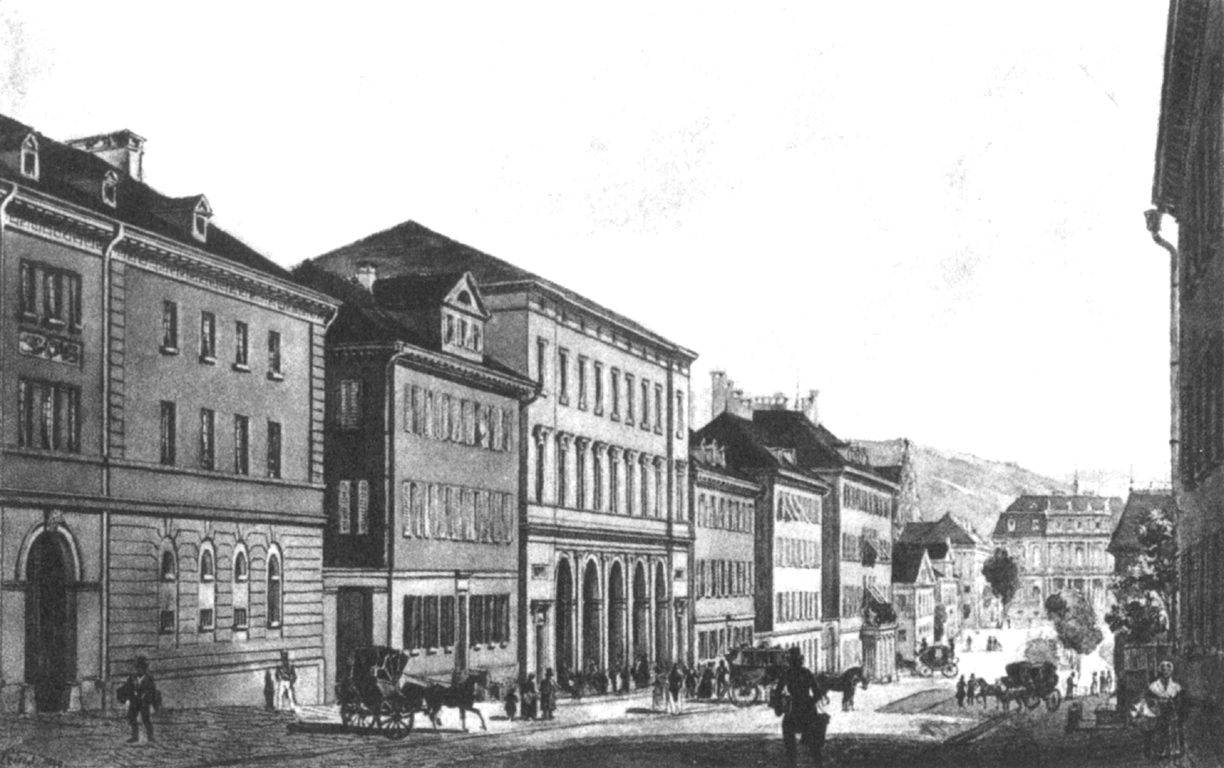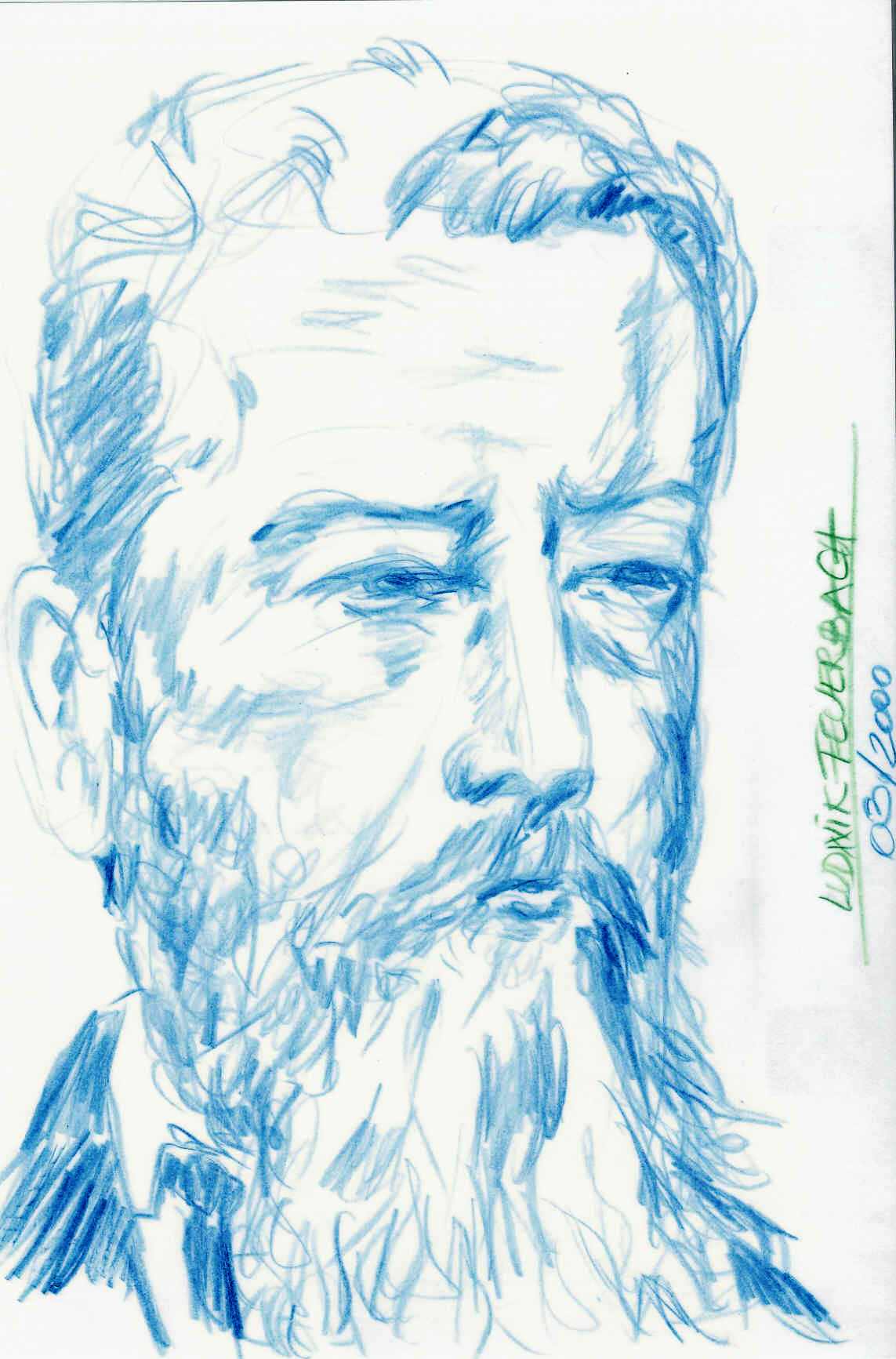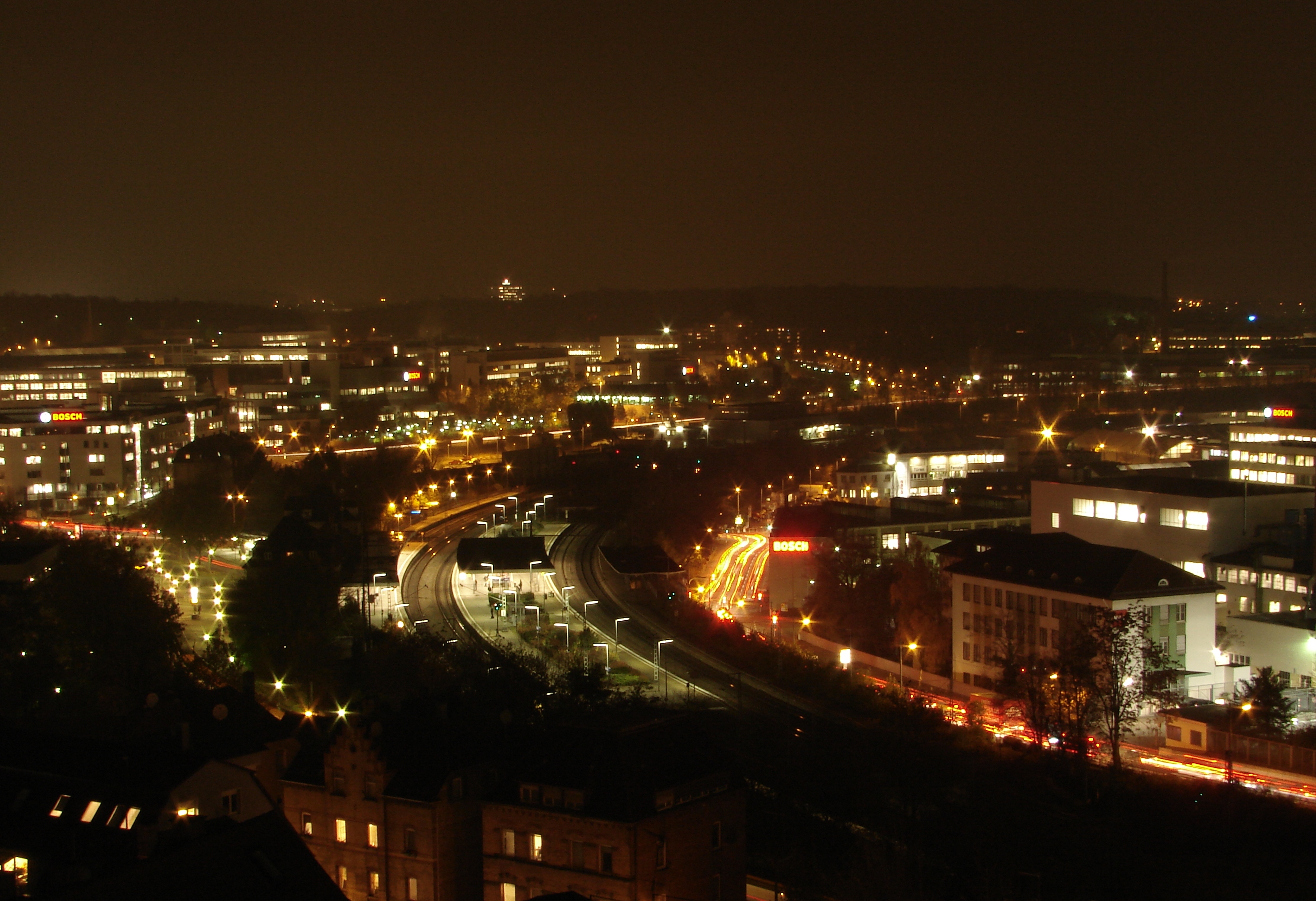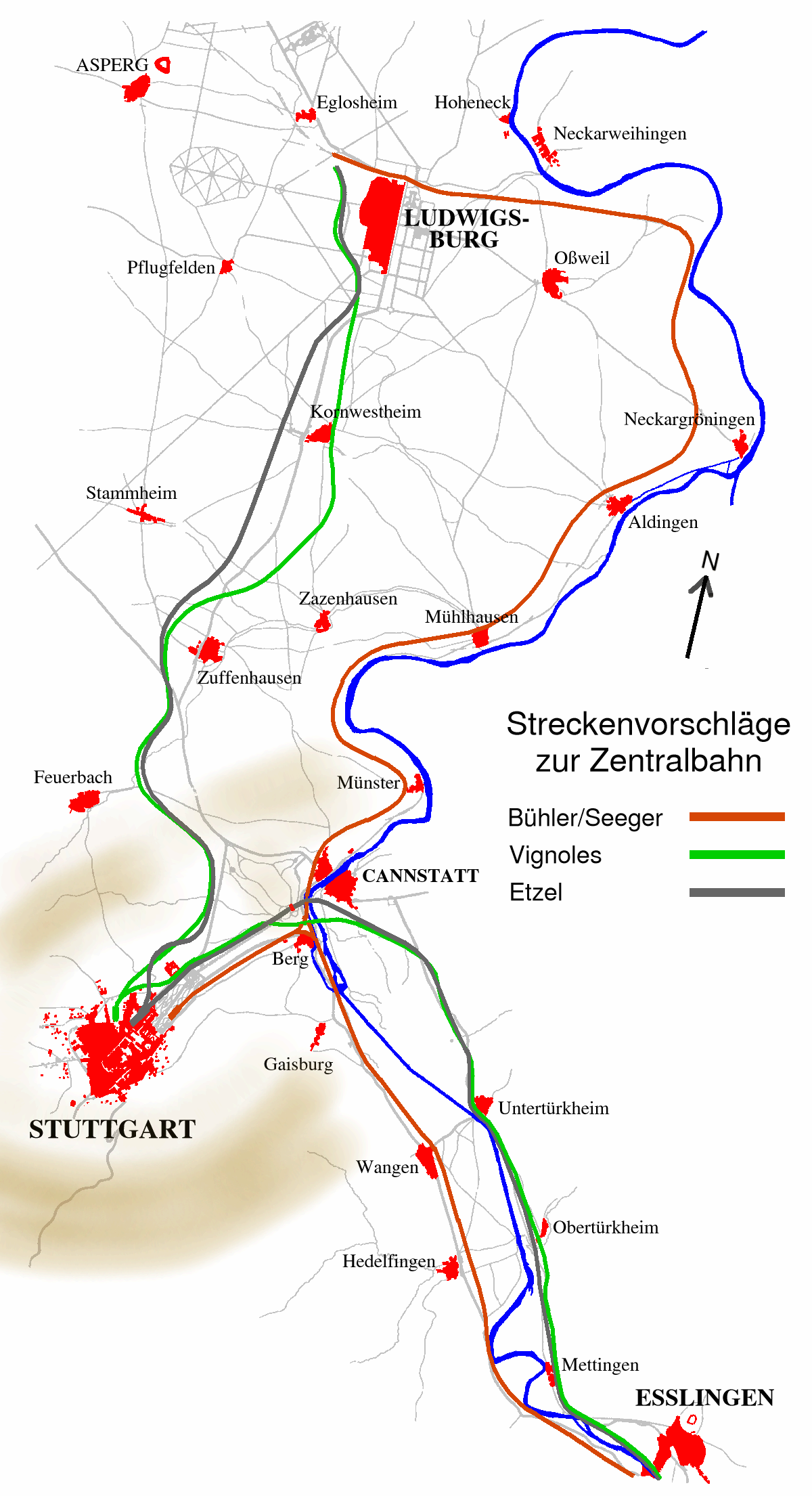|
Prag Tunnel
The Prag Tunnel is a railway tunnel in the German city of Stuttgart under the Prag, a ridge between the Stuttgart basin and Feuerbach. The two 680 metre-long bores of the tunnel connect Stuttgart North station with Feuerbach station. Trains from Stuttgart run through the tunnel towards Karlsruhe, Mannheim and Heilbronn on the Franconia Railway and the Mannheim–Stuttgart high-speed railway and towards Ludwigsburg and Leonberg on the Stuttgart S-Bahn. The tunnel runs in layers of Gipskeuper rock, containing anhydrite, which swell strongly when in contact with water. The track centres in the two tubes are 3.70 and 4.00 m apart. History The first tube of the Prag tunnel was built as part of the first railway in Württemberg, the Württemberg Central Railway between Esslingen, Stuttgart and Ludwigsburg. The first sod was turned on 26 June 1844 and marked the start of the construction of the Central Railway. Five shafts were sunk to enable the construction of the tunnel running ... [...More Info...] [...Related Items...] OR: [Wikipedia] [Google] [Baidu] |
Stuttgart Pragtunnel
Stuttgart (; Swabian German, Swabian: ; ) is the capital city, capital and List of cities in Baden-Württemberg by population, largest city of the States of Germany, German state of Baden-Württemberg. It is located on the Neckar river in a fertile valley known as the ''Stuttgarter Kessel'' (Stuttgart Cauldron) and lies an hour from the Swabian Jura and the Black Forest. Stuttgart has a population of 635,911, making it the list of cities in Germany by population, sixth largest city in Germany. 2.8 million people live in the city's administrative region and 5.3 million people in Stuttgart Metropolitan Region, its metropolitan area, making it the metropolitan regions in Germany, fourth largest metropolitan area in Germany. The city and metropolitan area are consistently ranked among the list of metropolitan areas in the European Union by GDP, top 20 European metropolitan areas by GDP; Mercer (consulting firm), Mercer listed Stuttgart as 21st on its 2015 list of cities by quality o ... [...More Info...] [...Related Items...] OR: [Wikipedia] [Google] [Baidu] |
Keuper
The Keuper is a lithostratigraphic unit (a sequence of rock strata) in the subsurface of large parts of west and central Europe. The Keuper consists of dolomite, shales or claystones and evaporites that were deposited during the Middle and Late Triassic epochs (about ). The Keuper lies on top of the Muschelkalk and under the predominantly Lower Jurassic Lias or other Early Jurassic strata. The Keuper together with the Muschelkalk and the Buntsandstein form the Germanic Trias Group, a characteristic sequence of rock strata that gave the Triassic its name. "Muschelkalk (geology)", Britannica Online Encyclopedia, October 2010, webpage: EB-39 Exposure The Upper Triassic is well exposed in Swabia, Franconia, Alsace and Lorraine and Luxembourg; it extends from Basel on the east side of the Rhine into Hanover, and through England into Scotland and north-east Ireland; it appears flanking the central plateau of France and in the Pyrenees and Sardinia. The Keuper sequence is li ... [...More Info...] [...Related Items...] OR: [Wikipedia] [Google] [Baidu] |
Stuttgart Central Station
Stuttgart Hauptbahnhof (; en, Stuttgart central station) is the primary railway station in the city of Stuttgart, the state capital of Baden-Württemberg, in southwestern Germany. It is the largest regional and long-distance railway station in Stuttgart, the main node of the Stuttgart S-Bahn network, and, together with the station at Charlottenplatz, it is the main node of the Stuttgart Stadtbahn. Located at the northeastern end of the ''Königstraße'', the main pedestrian zone of the city centre, the main line station is a terminus, whilst the subterranean S-Bahn and Stadtbahn stations are through-stations. The station is well known for its 12-storey tower with a large, rotating and illuminated Mercedes-Benz star insignia on top; the tower and station building are city landmarks. Plans for the controversial Stuttgart 21 project to convert the main line terminus station into an underground through station include the demolition of the side wings of the building, together wi ... [...More Info...] [...Related Items...] OR: [Wikipedia] [Google] [Baidu] |
Feuerbach Tunnel
Ludwig Andreas von Feuerbach (; 28 July 1804 – 13 September 1872) was a German anthropologist and philosopher, best known for his book ''The Essence of Christianity'', which provided a critique of Christianity that strongly influenced generations of later thinkers, including Charles Darwin, Karl Marx, Sigmund Freud, Friedrich Engels, Richard Wagner, and Friedrich Nietzsche. An associate of Young Hegelian circles, Feuerbach advocated atheism and anthropological materialism. Many of his philosophical writings offered a critical analysis of religion. His thought was influential in the development of historical materialism,Nicholas Churchich, ''Marxism and Alienation'', Fairleigh Dickinson University Press, 1990, p. 57: "Although Marx has rejected Feuerbach's abstract materialism," Lenin says that Feuerbach's views "are consistently materialist," implying that Feuerbach's conception of causality is entirely in line with dialectical materialism." where he is often recognized as a ... [...More Info...] [...Related Items...] OR: [Wikipedia] [Google] [Baidu] |
Stuttgart 21
Stuttgart 21 is a railway and urban development project in Stuttgart, Germany. It is a part of the Stuttgart–Augsburg new and upgraded railway and the Main Line for Europe (Paris—Vienna) within the framework of the Trans-European Networks. Its core is a renewed Stuttgart Hauptbahnhof, among some of new railways, including some of tunnels and of high-speed lines. The project was officially announced in April 1994. Construction work began on 2 February 2010. In March 2013, total costs were officially estimated at €6.5 billion, the previous estimate being €4.5 billion in 2009. In March 2022, Deutsche Bahn estimated the total cost at €9.15 billion. Heated debate ensued on a broad range of issues, including the relative costs and benefits, geological and environmental concerns, as well as performance issues. As of 2019, the start of operation is expected in late 2025, versus an initial estimation of 2019 (made in 2010). Concept The concept attempts to combine pla ... [...More Info...] [...Related Items...] OR: [Wikipedia] [Google] [Baidu] |
Stuttgart Stadtbahn
The Stuttgart Stadtbahn is a light rail system in Stuttgart, Germany. The Stadtbahn began service on 28 September 1985. It is operated by the Stuttgarter Straßenbahnen AG (SSB), which also operates the bus systems in that city. The Stuttgart Stadtbahn is successor system of a tram network ('' Straßenbahnen'') that characterized the urban traffic in Stuttgart for decades. The network of the Stadtbahn covers much of Stuttgart and also reaches the neighbouring towns of Remseck am Neckar, Fellbach, Ostfildern, Leinfelden-Echterdingen and Gerlingen (clockwise). Currently, the Stuttgart Stadtbahn system is made up of fourteen main lines (U1-U9, U12-U15, U19), a special event line (U11) and two temporary lines during construction site, serving 203 stations, and operating on of route. In 2014, the Stuttgart Stadtbahn carried 174.9 million passengers. Lines , the Stuttgart Stadtbahn system is made up of fourteen main lines (U1-U9, U12-U15 and U19), two special lines (during the c ... [...More Info...] [...Related Items...] OR: [Wikipedia] [Google] [Baidu] |
Stuttgart-Feuerbach Pragtunnel 20060621
Feuerbach is a borough (''Stadtbezirk'') of the city of Stuttgart. Its name is derived from the small river of the same name that flows from the neighboring district of Botnang through Feuerbach. Feuerbach is home to one of Germany's biggest industrial giants and is surrounded by the districts of Zuffenhausen, Bad Cannstatt, Stuttgart-North, Stuttgart-West, Botnang and Weilimdorf. History The remains of a prehistoric settlement were uncovered in 1904, when the pastor of Feuerbach, Richard Kallee excavated, archeologically documented and published a total of 102 Alemannic sandstone tombs and cists. Heinz Krämer: Fertig Feuerbach! Richard Kallee, Pfarrer und Geschichtsforscher '' in German, DRW Verlag, Leinfelden-Echterdingen, 2004, . Was die alten Steine in Feuerbach erzählen'' in German, 1923. Together with his helpers he took great care to recover 760 artifacts from these Alemannic graves: skulls and bones, coins, pottery shards, combs, necklaces, belts, locks, swords, spears ... [...More Info...] [...Related Items...] OR: [Wikipedia] [Google] [Baidu] |
Gäu Railway
In the south German language (of the Alemannic-speaking area, or in Switzerland), a ''gäu'' landscape (''gäulandschaft'') refers to an area of open, level countryside. These regions typically have fertile soils resulting from depositions of loess (an exception is the ''Arme Gäue'' Poor Gäus"of the Baden-Württemberg Gäu). The intensive use of the ''Gäu'' regions for crops has displaced the originally wooded countryside (→''climax vegetation'' – in contrast with the steppe heath theory and disputed megaherbivore hypothesis). The North German equivalent of such landscapes is ''börde.'' See also * Gau (territory) – also gives the etymology and language history of ''Gäu'' * Gäu – regions with the name * Natural regions referred to as ''Gäu plateaus'': ** Neckar and Tauber Gäu Plateaus ** Gäu Plateaus in the Main Triangle ** Werra Gäu Plateaus * Gäuboden * Altsiedelland The ''Altsiedelland'' ("old settlement land") is a German term that refers to populated areas ... [...More Info...] [...Related Items...] OR: [Wikipedia] [Google] [Baidu] |
Esslingen (Neckar) Station
Esslingen (Neckar) station is the most important station in the town of Esslingen am Neckar in the German state of Baden-Württemberg and is located from Stuttgart Hauptbahnhof on the Fils Valley Railway. History The former imperial city of Esslingen (then spelt ''Eßlingen'') was at the end of the first railway line in Württemberg, the Württemberg Central Railway (german: Württembergischen Centralbahn), connecting Esslingen, Stuttgart and Ludwigsburg. Benefitting from the flat route along the Neckar, the work went forward quickly and Eßlingen station was opened to traffic on 20 November 1845. It had a two-storey entrance building and a locomotive depot. Later a residence for railway officials was added. Not all members of the district's council saw the new transport mode as an advantage. It was the end of the line, but it was not long before construction of the Fils Valley line continued. They feared that Eßlingen station would become a minor maintenance station on the Ea ... [...More Info...] [...Related Items...] OR: [Wikipedia] [Google] [Baidu] |
Württemberg Central Railway
The Central Railway (german: Zentralbahn or ''Centralbahn'') was the first phase of the Württemberg railways. It was built between 1844 and 1846 by the Royal Württemberg State Railways (''Königlich Württembergischen Staats-Eisenbahnen'') and consisted of two branches, running from Stuttgart to Ludwigsburg in the north and from Stuttgart to Esslingen in the east. The term ''Zentralbahn'' did not last long, as the two branches were soon extended to Heilbronn and Ulm, and were then known as the ''Nordbahn'' ( Northern Railway) and the ''Ostbahn'' (Eastern Railway) or ''Filsbahn'' ( Fils Valley Railway). The Ludwigsburg–Stuttgart–Esslingen section as a whole was still of great importance, since it continued to be the core of the network and was the busiest section of the Württemberg railways and it also served the largest metropolitan area in the country. For these reasons, it has undergone many changes and enhancements over time. Route The two branches began at Zentra ... [...More Info...] [...Related Items...] OR: [Wikipedia] [Google] [Baidu] |
Anhydrite
Anhydrite, or anhydrous calcium sulfate, is a mineral with the chemical formula CaSO4. It is in the orthorhombic crystal system, with three directions of perfect cleavage parallel to the three planes of symmetry. It is not isomorphous with the orthorhombic barium ( baryte) and strontium ( celestine) sulfates, as might be expected from the chemical formulas. Distinctly developed crystals are somewhat rare, the mineral usually presenting the form of cleavage masses. The Mohs hardness is 3.5, and the specific gravity is 2.9. The color is white, sometimes greyish, bluish, or purple. On the best developed of the three cleavages, the lustre is pearly; on other surfaces it is glassy. When exposed to water, anhydrite readily transforms to the more commonly occurring gypsum, (CaSO4·2H2O) by the absorption of water. This transformation is reversible, with gypsum or calcium sulfate hemihydrate forming anhydrite by heating to around under normal atmospheric conditions. Anhydrite is comm ... [...More Info...] [...Related Items...] OR: [Wikipedia] [Google] [Baidu] |
Stuttgart S-Bahn
The Stuttgart S-Bahn is a suburban railway system (S-Bahn) serving the Stuttgart Region, an urban agglomeration of around 2.7 million people, consisting of the city of Stuttgart and the adjacent districts of Esslingen, Böblingen, Ludwigsburg and Rems-Murr-Kreis. The Stuttgart S-Bahn comprises seven lines numbered S1 through S6 and S60, and is operated by ''S-Bahn Stuttgart'', a subsidiary of Deutsche Bahn. The system is integrated with the regional transport cooperative, the Verkehrs- und Tarifverbund Stuttgart (VVS), which coordinates tickets and fares among all transport operators in the metropolitan area. Lines All lines lead through the city centre of Stuttgart. The northeastern end of the tunnel (from the tracks near '' Stuttgart Hauptbahnhof'' through '' Schwabstraße'') was the first part of the tunnel to open and has been used since the beginning, the southwestern end from ''Schwabstraße'' through Universität since 1985. The main node to change for ''Stu ... [...More Info...] [...Related Items...] OR: [Wikipedia] [Google] [Baidu] |






